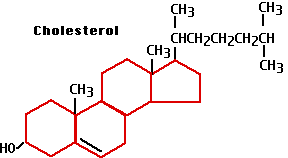Cholesterol is small molecule, one of the steroids. It is essential to life. It has also been responsible for 17 Nobel Prizes, countless pages of reports in scientific journals and the popular press, and mounting anxiety on the part of health-conscious people. Why?

The human body contains about 100 g of cholesterol. Most of this is incorporated in the membranes from which cells are constructed and is an indispensable component of them. The insulating layers of myelin wound around neurons are especially rich in cholesterol. In far smaller quantities, but no less important, cholesterol is used to synthesize several steroid hormones, including the sex hormones estrogen, progesterone, and testosterone as well as the corticosteroids. Cholesterol is also the precursor from which the body synthesizes vitamin D.
One of the major uses of cholesterol is the synthesis of bile acids. These are synthesized in the liver from cholesterol and are secreted in the bile. They are essential for the absorption of fat from the contents of the intestine. A clue to the importance of cholesterol is that most of the bile acids are not lost in the feces but are reabsorbed from the lower intestine and recycled to the liver. There is some loss, however, and to compensate for this and to meet other needs, the liver synthesizes some 1500-2000 mg of new cholesterol each day. It synthesizes cholesterol from the products of fat metabolism.
There is also an unceasing transport of cholesterol in the blood between the liver and all the other tissues. Most of this cholesterol travels complexed with fatty acids and protein in the form of low density lipoproteins (LDLs). Cells that need cholesterol trap and ingest LDLs by receptor-mediated endocytosis.
Cholesterol can also create problems. Cholesterol in the bile can crystallize to form gall stones that may block the bile ducts. Cholesterol is also strongly implicated in the development of atherosclerosis: fatty deposits (plaques) that form on the inside of blood vessels and predispose to heart attacks. The major culprit seems to be levels of LDLs that are in excess of the body's needs.
The level of cholesterol in the blood is measured in milligrams per deciliter (mg/dl), which is equivalent to parts per 100,000. The levels range from less than 50 in infants to an average of 215 in adults and to 1,200 or more in individuals suffering from a rare, inherited disorder called familial hypercholesterolemia. For those of us in the normal range, approximately two-thirds of our cholesterol is transported as LDLs. Most of the rest is carried by so-called high density lipoproteins (HDLs).
Because of their relationship to cardiovascular disease, the analysis of serum lipids has become an important health measure.
The table shows the range of typical values as well as the values above (or below) which the subject may be at increased risk of developing atherosclerosis.| LIPID | Typical values (mg/dl) | Desirable (mg/dl) |
|---|---|---|
| Cholesterol (total) | 170-210 | <200 |
| LDL cholesterol | 60-140 | <130 |
| HDL cholesterol | 35-85 | >35 |
| Triglycerides | 40-150 | <135 |
In 1974, the National Institutes of Health and the American Heart Association set 200 mg/dl as a desirable goal for total cholesterol in middle-age adults and 180 mg/dl for those under 30 years of age. Recent studies suggest that reducing cholesterol still further may further reduce the risk of heart disease. Unfortunately, most of the studies done so far have not been able to clearly separate the effect of cholesterol-lowering drugs from that of altered diet.
There is little question that people with high (>240 mg/dl) levels of cholesterol can lower their risk of developing heart disease by lowering these levels. There is no question that cholesterol (mainly LDL) levels can be reduced with the aid of drugs.
There are two major classesCareful attention to diet may by itself lead to a reduction in cholesterol levels. In one study, men with high (>265 mg/dl) levels were able to lower these an average of 3.5% (10 mg/dl) by diet alone. Their diets were low in fat as well as low in cholesterol, and it was not - and still is not - clear as to what aspect of the diet contributed to the modest reduction. Cholesterol is made from fat and lowering the proportion of fat in the diet will probably help. Favoring unsaturated fats over saturated fats appears to be beneficial. There is little evidence that lowering one's intake of cholesterol is, by itself, useful. An average intake of cholesterol of 300-500 mg per day is joined in the intestine by several times that amount that has been synthesized by the liver and appears to have little or no effect on blood levels of cholesterol. So when choosing between the pat of butter and the pat of margarine, it is not the 30-odd mg of cholesterol in the butter (vs. 0 in the margarine) but its high content of saturated fat (over 3 times that in the margarine) that is probably significant.
| Welcome&Next Search |